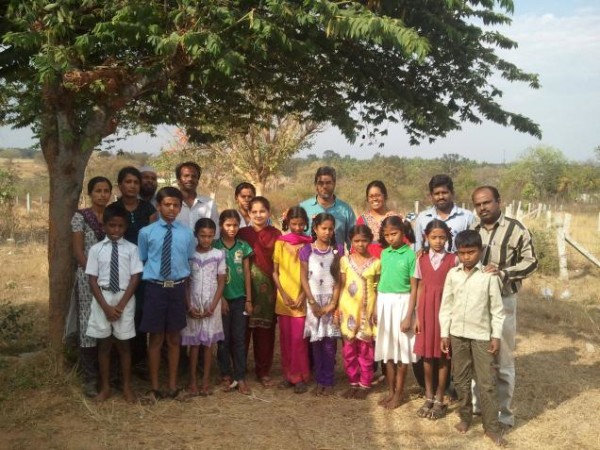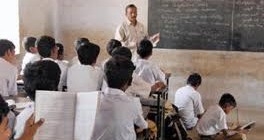In Pic :The office bearers committee of the Makala Kavalu Samiti (MAKASA). Photo: Kumar Sringeri
In a small town in Karnataka, government-school students are working to ensure that their schools meet the infrastructure norms of the RTE Act. Can this model be replicated elsewhere in the country?
Kishore Mahadevaiah, a Std VII student, is describing his ideal school. “The school should be very clean and neat. In every class, there should be teaching and learning materials and sports materials and qualified teachers. And there should be a van to bring us from our homes.” He leans forward as he speaks, his eyes widening as if he is looking directly at the place he envisions. “Basically, they should get all the facilities in the school, and every class should have one room and a teacher for every subject. Every child should have a computer.”
It’s a hazy Saturday morning in Ramanagara, a small town in Bannikuppe Gram Panchayat that is famous for its silk production and striking rocky landscape. A dozen children sit cross-legged around Kishore on the striped green carpet spread across the floor of an unassuming three-roomed building set slightly back from the bustling traffic and nod in agreement. These children share Kishore’s belief that his dream school can become — indeed, must become — more than just a dream. In fact, these students have made it their mission to turn their educational dreams into reality.
Kishore is the president of the office-bearers’ committee of the Makala Kavalu Samiti, MAKASA for short. In English, they call themselves the Children’s Vigilance Committee for the Effective Implementation of the Right to Education (RTE). Once a month, these government school students — all of whom were elected by their peers — gather to compare and exchange notes on the infrastructure and education related issues in their schools, brainstorm ways to address individual challenges, and enjoy the company of peers and adults who believe, like they do, that education is a fundamental human right.
In fact, the government of India agrees with them: the passage of the landmark Right of Children to Free and Compulsory Education Act of 2009 provides the national legislative framework that these children use to advocate for themselves and their communities. Because of the Act (known colloquially as the Right to Education Act, or RTE for short), India has pledged to do more than just simply build schools. Instead, it has promised to create an educational system with minimum standards for everything from teacher qualifications to curriculum to infrastructure. Consequently, local stakeholders are able to invoke RTE to demand resources for improving government schools —and what stakeholders are more important than the students who attend these schools on a daily basis?
One of the most promising aspects of the law is the requirement to form school monitoring committees consisting of parents, teachers, and other stakeholders, including students. (In Karnataka, where MAKASA meetings take place, they are known as school development monitoring committees, or SDMCs.) The committees empower local parents and students to monitor local administration of RTE. This task is particularly pressing given the rapidly approaching March 31, 2013 deadline, when the infrastructure norms prescribed in the schedule to the Act are supposed to be fully implemented.
As the MAKASA office-bearers will tell you, there is still much to be done, especially when it comes to infrastructure. According to RTE, every school should have basic amenities including clean and safe drinking water, functioning toilets separated by gender, adequate teaching and learning materials, a library, and a playground. Plus, the schools should be clean and neat, as Kishore described.
Rather than simply complaining about the gaps between implementation and reality, the MAKASA students have taken an active role in addressing them. Std IV student Usha Kemmaraiah, for example, convinced her school in Avaragere to clean up the school yard. Std V student Chandana worked with her school at Kethiganahalli to renovate dilapidated classrooms; one is already finished. Another Std V student Bhavyashri Govindaraj successfully advocated for regular access to clean drinking water in her school in Kempadyapanahalli.
The students of MAKASA base their advocacy on a comprehensive understanding of their rights under RTE. Bhavyashri explained, “The main use [of RTE] is that no child should be outside, all children should attend schools compulsorily. All children should know all their rights. They should get quality education.” The Std V student clearly articulates an important distinction between most other education laws and RTE: education is more than just attending a school. It’s attending a good school.
The MAKASA was the brainchild of Dr. Niranjan Aradhya, Fellow and Programme Head of the Right to Equitable Quality Education Programme at the Centre for Child and the Law (CCL) at the National Law School of India University. A long-time advocate for education as a human right, Dr. Aradhya describes himself as an academic and an activist who believes in “critical and constructive engagement with the state”.
His actions support his claim: he is in the field almost every day, and can rarely be found behind his desk at the University.
Dr. Aradhya believes that RTE represents ideological progress that must be translated into action to realise its full potential. He emphasises, “We must remember there is a difference between the RTE act and RTE as a fundamental human right. Enactment is only a small procedure to move towards RTE as a larger goal.”
In the interest of this goal, Dr. Aradhya and his staff organised the children, trained local adults to facilitate meetings, and created systems to help the children learn and utilise levers of change. They created a training guide for the children, and Dr. Aradhya himself routinely facilitates MAKASA meetings at the three-room Field Extension Office. Additionally, Dr. Aradhya and his staff at CCL help students monitor progress on their various cases. For example, he created a form in Kannada that students fill out and submit to the School Development Monitoring Committees (SDMCs) or, if the complaint goes unanswered, to Gram Panchayats. The student keeps a copy, the government body keeps a copy, and CCL keeps a copy to monitor the case.
MAKASA has celebrated a number of victories within the Gram Panchayat in Ramanagar district where they work. But the experience has also been transformative for students who now identify themselves as part of a collective of advocates who have a strong voice within their communities and an understanding of their schools as part of a larger system.
“Before, they had no space to air questions, and they didn’t know about problems in other schools,” Dr. Aradhya said.
According to Kishore, that has changed. “This helps us know what is there in other schools so we can compare.” Kishore and his peers say that knowing what other schools have helps them identify the deficiencies in their own buildings, and emboldens them to ask for what they believe they deserve. In fact, when asked to identify the best thing about MAKASA, the children almost unanimously agreed that it was making new friends — including adults. As Std V student Lakshmidevi Kumar put it, “The best things are good friends, good teachers, and good masters.”
The office-bearers represent the highest committee in a chain of elected representatives. In Bannikuppe Gram Panchayat, there are 14 schools, each of which has student representatives on their SDMCs: one boy and one girl. These student representatives come together to constitute the executive committee of MAKASA. The executive committee in turn elects the office-bearers — at least one from each school — that make up MAKASA. As Std VII student Satish Kaggalappa from Bairagi Colony says proudly, “We elected the committee in a very democratic way.”
This is one of many lessons in good governance that MAKASA students learn. Prathima N., a village education coordinator from the panchayat who holds a Masters in social work, notes, “Their [the children’s] leadership has increased. They have developed a questioning attitude, and they are able to identify problems.”
Not all the adults in the community recognise the children’s potential. Shashikala Ramachandraiah, the assistant village education coordinator for her panchayat, notes, “Still the attitude in the panchayat is not up to the mark.” She says that children do not receive formal responses from panchayat members, who are much more professional when interacting with adults. However, she says that MAKASA is slowly changing this. “At least the panchayat is recognising children have rights and they can also certainly tell us.”
A turning point was the annual children’s Gramma Sabha meeting this past December. During this meeting, Dr. Aradhya helped the children create a presentation detailing the infrastructure issues that compromised their ability to learn. The problems the children identified range from crumbling compound walls to snake infestations to a lack of clean drinking water.
The children had a colossal effect. Dr. Aradhya remembers, “The president said, ‘the children have asked for so much and I have nothing to say.’ He said he would talk to them in three months when he started resolving the issues.” Dr. Aradhya remembers that he had tears in his eyes when he realised the impact that the children had.
Kumaraswamy, another staff member in the team, believes that this reaction is symptomatic of the power of children. “When an adult is presenting a problem, there are chances of politicising it. Because, in one way or another, an adult always belongs to some political party. In the case of children, one is their innocence; another, they are not into any kind of politics..” This purity of motive, he believes, can be transformational.
The panchayat members who support MAKASA believe that Dr. Aradhya has created a promising model that can be widely replicated, if local adults are willing to put in the time to receive training and facilitate meetings.
Unfortunately, the majority of letters in Dr. Aradhya’s file have gone unanswered. Many schools still lack basic amenities including clean drinking water, proper toilets, and useable playgrounds. Panchayats, who are ultimately responsible for RTE implementation, often lack the resources to meet minimum quality standards, even if they support them. Dr. Aradhya believes that this problem should be addressed in future budgets, which must prioritise improving existing government schools rather than investing in private schools or attempting to create a new system from scratch.
In Bannikuppe Panchayat of Ramanagara, at least, it is unlikely that the infrastructure requirements of RTE will be met by the March 31 deadline. However, the children of MAKASA represent the great hope embedded in the framework of RTE. Fundamentally, the act gives India’s people — and, especially, India’s children — the power to make their dream schools into realities. This is the Act’s greatest contribution: it is based on the revolutionary idea that we all have the responsibility to help children make their dreams come true.






Leave a reply